Does BMW’s first attempt at superbike success live up to the hype? Come for a ride at Phillip Island's Aussie launch to find out!
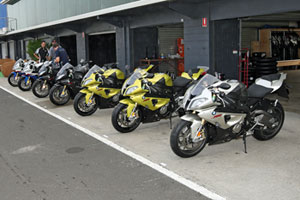
2010 BMW S 1000 RR SPECIFICATIONS
ENGINE
Engine type: Inline four-cylinder, 16-valve, four-stroke, liquid-cooled, DOHC
Bore x stroke: 80mm x 49.7mm
Displacement: 999cc
Compression ratio: 13:1
Transmission: Six speed
Power (claimed): 193hp
Torque (claimed): 82.5ft-lbs
CHASSIS
Frame type: Bridge-type aluminium alloy
Front suspension: Fully-adjustable 46mm inverted Sachs fork
Rear suspension: Fully-adjustable Sachs shock absorber
Wheelbase: 1432mm
Wheels (front/rear): 10-spoke cast aluminium alloy 17 x 3.5 / 17 x 6.0
Tyres (front/rear): Metzeler Racetec K3 120/70-17 / 190/55-17
Brakes (front/rear): Brembo Twin 320mm discs, four-piston calipers, radially mounted / Brembo 220mm disc, single piston calliper (Race ABS on Sport model)
DIMENSIONS
Weight (claimed): 204kg (wet)
Seat height: 820mm
Fuel capacity: 17.5L
PURCHASE DETAILS
Price: $21,900 or $24,400 for Sport
Colour options: Thunder Grey Metallic; Acid Green Metallic; Mineral Silver Metallic; Motorrad Motorsport (extra $765).
Test bike from: BMW Motorrad Australia
www.motorcycles.bmw.com.au
It really was only a matter of time before BMW would enter the superbike segment with another classy European model to take on the best of the Japanese litre bikes.
The time is finally here in 2010 as deliveries of the striking S 1000 RR sportsbike are just beginning, the first major and welcome surprise being the flash price tag of just $21,900 plus on-roads.
BMW introduces its superbike as a contender in the red hot category at its first attempt, the German manufacturer releasing a 999cc inline four-cylinder complete in a conventional bridge-type aluminium alloy frame.
The big news surrounding BMW’s superbike campaign is the electronic trickery that’s available straight off the showroom floor when laying down your hard-earned dollars.
BMW Motorrad Australia has made two distinct models available. One is the base model, while the other is what they’ve named an S 1000 RR Sport – complete with DTC Dynamic Traction Control and Race ABS anti-lock braking.
For just $24,400 plus on-road costs, you’ll be getting a heck of a lot of motorcycle from BMW with the DTC and ABS, while both the standard and Sport models come equipped with the quick-shifter HP Gearshift Assistant.
And the good news for BMW? Most customers who are purchasing the RR are going for the more expensive Sport version, which is the obvious choice considering the massive gains for just $2500 extra.
As you’ll read below, the multi-mode DTC and ABS are absolutely astonishing for a production bike, with BMW benefitting from development work carried out by World Superbike racers Troy Corser and Ruben Xaus, not to mention the likes of Aussie Steve Martin and Kevin Curtain during the process.
In fact, over one million kilometres were logged during testing before the bike’s release, with a massive 200 changes being updated for the released version when compared with the pre-production model that has been doing the rounds in Australia since late last year.
Okay, back to the surprises.
Surprise two with the S 1000 RR so far is the fact that at the international launch at Portimao in Portugal last year, over 160 journalists put the bike through its paces and all kept it up right during the launch – something pretty much unheard of and a brilliant strike rate!
And number three, I’m going to cut right to the chase with this one. BMW claims 193 horsepower and 82.5 foot pounds of torque. Well, without running the S 1000 RR on the dyno, I wouldn’t bet that they’re inflating the figures as so many manufacturers seemingly do in their press kits.
Open the throttle and hold on for the ride, because this superbike may just be the fastest standard motorcycle on the market – something that we’ll be able to confirm in future comparisons back-to-back.
The Australian national launch for the S 1000 RR was situated at Phillip Island in Victoria, home of the local round of Superbike World Championship where we’ll see Corser and fellow Aussie Andrew Pitt contest the season opener on Beemers next weekend.
Official Superbike development rider and current Endurance World Champion Steve Martin was on hand for the launch, stating that this is the closest road-going model to the actual race derivative that he’s ever experienced.
Upon my first inspection of the S 1000 RR I could see that it’s a quality bike from the ground up despite it being BMW’s first attempt at creating a superbike.
The shape of the bike, especially the asymmetrical headlights, is ultra unique, with quality components and four differing colour schemes making for a load of options to start with.
You can go for the Thunder Grey Metallic that we’re testing, the Acid Green Metallic, Mineral Silver Metallic or the Motorrad Motorsport option, but the last one will cost you an extra $765 to look like Corser.
To be completely honest it’s hard edged and features plenty of black that signifies it’s a serious weapon that’s designed to get down to business. It’s missing the sparkling chrome of Aprilia’s RSV4 that makes that bike look so good at a standstill, but the build quality is high, no doubt.
Sit on the BMW and it just feels right. The seat is comfortable, handlebars in a perfectly reachable position, rear view easy to see in the mirrors and tank narrow enough for you to feel as though you’re in complete control.
Glance toward the front and you’ll notice the effective instrument panel with an analogue tacho along with a pair of digital displays that has the usual array of warning lights, featuring a gear indicator and also the engine mode (see tech breakout for more details) currently chosen by the rider, that is Rain, Sport, Race or Slick.
The rider is able to switch from one mode to the other from the right-hand end of the handlebar also while riding, simply pulling the clutch and turning the gas handle to the idle position to confirm the change in mode.
The instrument cluster has both race and track modes, enabling riders to see information on current, best and latest lap times.
It’s also got a gearshift light integrated in the system and adjustable in terms of frequency and brightness, and may also be used as an engine speed indicator for starting in race style, flashing on and off at the appropriate speed for an optimum start.
Once on track for session one, BMW’s Miles Davis instructed us to use the session to get the feel for the Rain mode that limits power to 150 horsepower – with the DTC kicking in as you lean the bike more than 38 degrees. The final trick was to lap in fourth gear for the entire session – Turn Four, MG and all!
Although limiting power around the Island is kinda like waving a red flag in front of a bull, it was interesting to get my first understanding of the engine character as the DTC cut in and out as I gave it full gas on the corner exits.
The torque is also noticeable even when in fourth gear, grunting out of each turn and pulling fourth gear without hesitation even out of turns that I’d usually take in second. Impressive.
Session two saw us step up to the Sport mode in any gear that we wanted to, boosting the power to its claimed maximum of 193hp, however the DTC would kick in at 45 degrees with less ABS – yes, the launch was all on the up-spec Sport model.
It was again interesting to feel the DTC limit power until I sat the bike up past the magic lean angle of 45 degrees, bursting in power and jumping out of the corner in my first taste of the ponies on hand.
There’s no doubt the S 1000 RR is shockingly fast in a straight line, something that I’d be amazed by again and again during the Island launch.
Since we were permitted to change gears at attempt number two, this gave me my first impression of the quick-shifter – man, does it work wonders just like I remember during my racing career.
The good thing is that it works not only at high revs as most quick-shifters are designed to do, but also at minimal revs when cruising at around 2000-3000rpm, which is perfect for the real world.
You’ll notice a slight pop without having to release the throttle, and bam, you’re a gear higher without a sweat. If you are old school and can’t help but to engage the clutch at the same time, as soon as you pull on the level it will essentially switch off the quick-shift feature.
Get used to it and you’ll absolutely love it.
Session three saw another step up to the Race level in the modes, now requiring a lean angle of 48 degrees or more before the DTC kicks in and proving to be one of my favourites of the test.
You can roll into the corners at speed, put your knee on the deck and be assured that you’ll have the safety of DTC backing you up in case you get throttle happy, before the power would burst you out of the turn in an epic fashion.
Once getting more comfortable on the track I could really push the limit to feel the Sachs suspension at play, providing plenty of feedback direct through the seat and also steering in an incredibly precise manner.
Granted, I’d never ridden on Metzeler’s Racetec K3 tyres before, nor had I ever ridden with Sachs suspension at the front and rear before on a race track, however the end result is a confidence-inspiring combo that goes hand-in hand with the DTC and ABS of the S 1000 RR.
In reality, the S 1000 RR does so many things well. It stops quickly under brakes, is easy to turn into the corners, holds its line mid-turn, and has good stability when you’re on the gas. Sure, you could wring its neck and force some issues if you’re Corser, however for a first shot at the title I give the Germans a big thumbs up all-round.
One of the coolest design features of the entire bike is so simple, yet so helpful if you’re one to fiddle with your suspension settings: the key is designed to fit perfectly as a suspension adjuster tool!
It’s obvious that the suspension and even the seat comfort would convert to the road with no problems, perhaps being the most road oriented Euro superbike of the lot when comparing it to the 1198, RSV4 or F4 range.
It’s track prowess is superb, while we’ll have to wait a little longer before I can confirm my predictions on the public roads.
You can brake as hard as you dare with the Brembo stoppers, the front not having any pulsating despite it featuring ABS, while you can stomp on the rear and you’ll feel it automatically adjusting to limit rear tyre locking.
This is a strange feeling when you’re used to “backing it in” if need be on a non-ABS model, however step it up to the Slick setting and you’ll have that added luxury of throwing a slide into the turns if you’re feeling like a showman.
You’ll appreciate the slipper-style clutch when hard under brakes, too.
The Slick mode is set so only the front wheel will have the ABS feature, essentially turning it off at the rear wheel and putting the rider back in complete control of the braking power.
Also differing in the Slick mode is the fact that you can wheelie to 23 degrees for up to five seconds, removing the anti-wheelie aspect of the electronics that’ll otherwise be an embarrassing moment if you try to pop the front wheel up in the other modes.
An interesting thing to note is that the ABS works independently at the front and rear, except for in Rain and Sport modes if rear wheel lift is detected under heavy braking – initiating the rear ABS.
Another thing to note is the sharp feel of the buttons situated on the handlebars to control all the features as well as the regular indicators and whatnot. They’re accurate with just the slightest pressure.
Once up to speed in Race mode though, the attention-grabbing DTC does somewhat limit my speed out of corners on the flowing turns of Phillip Island, making me wait until I can extract the full power of the bike.
After a couple of sessions on the Race mode I worked up to giving the Slick mode a go, again able to lap slightly faster around the circuit with the DTC not activated unless you’re carrying a lean angle of over 53 degrees.
You can accelerate hard on this setting and also brake deep into the turns, returning a more usual feeling into the turns without the ABS on the rear, while the capabilities of wheel-standing off the turns is good fun too with all that power on tap.
Rev it through the range and the power will kick in from down low, coming on strong through the mid-range and absolutely firing once up get over 10,000rpm and inch toward the magic mark of 13,000 before clicking the next gear.
Top-end is superb as the variable intakes open up and boost power as you tuck in down Gardner Straight.
If you want to turn the ABS or DTC off altogether you can, however German tester and ex-GP star Jurgen Fuchs has proven that you can lap just as fast on track while utilising the added safety features according to BMW. In fact, only two percent of riders have proven faster so far without the ABS on.
Even better to note is that you can actually turn both options off on the fly while riding if you want, not requiring you to pull up in order to adjust the settings you’re looking for.
As I stated above, and will highlight again, the power output is phenomenal. It’s race-like in the way its delivered and incredible to think that it’s a production model. Adding an Akrapovic pipe will add another five to seven ponies, also saving six kilos when compared with the standard exhaust.
It’s clear that I’m impressed with the BMW S 1000 RR. It does so many things well and adds a new dimension to sportsbike riding, giving us plenty to fiddle with and requiring test rides like this to be longer than ever so we can fit all the details in.
I wouldn’t have it any other way.
TECHNICAL INFORMATION
Engine
As an all-new development from the ground up from BMW, the 16-valve, 999cc, DOHC, inline four-cylinder engine featured in the S 1000 RR boasts a massive claimed power output of 193 horsepower (181 of those at the rear wheel!).
With a bore and stroke of 80 x 49.7mm, the particularly short stroke/bore ratio of just 0.621 provides the foundation for a high-output power unit, featuring the biggest bore of all in the 1000cc sportsbike category.
Its claimed maximum output is at its peak at 13,000rpm and its peak torque is 82.5 ft-lbs at 9750 rpm, with riders at the launch able to feel every ounce of those claimed figures.
And with its engine weighing just 59.8 kilograms, the S 1000 RR has the lightest 1000cc four-cylinder in its entire segment.
Despite the large cylinder bore of 80mm, engine width at crankshaft level is only 463mm, and at 558mm, the engine is also very low in terms of its overall height.
The cylinder axis on the S 1000 RR power unit is tilted 32 degrees to the front, providing an optimum centre of gravity as well as the front wheel-oriented weight distribution so essential on a superbike.
The crankshaft on the S 1000 RR is forged out of one single piece of heat- treated steel, runs in anti-friction bearings and comes with the traditional crank angle of 180 degrees for a consistent firing distance at all times. Both the main and the conrod bearing journals measure 34mm in diameter.
Its connecting rods are forged out of lightweight heat-treated steel. Measuring 103mm in length, they help to keep the engine low and compact, saving space and lowering the centre of gravity even further.
The upper conrod opening comes without a bearing bush and measures 17mm in diameter. Two lubrication openings in the upper eye of the conrod and positioned at an angle of 45 degrees to the vertical axis of the rod ensure a reliable supply of oil to the piston pin bearings at all times according to BMW.
The cylinder liners with their nikasil coating incorporate forged lightweight box pistons featuring a very short piston skirt. Further highlights are the two narrow piston rings optimised for minimum friction and a three-piece oil scavenger ring.
To remove and dissipate heat, the pistons are cooled at the bottom under high thermal loads by oil injection nozzles in the crankcase.
Split horizontally down the middle of the crankshaft, the cylinder crankcase is made of extra-strong aluminium alloys, with a compact die-cast upper section forming a stiff combination with the four cylinders and the upper bearing mounts for the crankshaft.
The upper half of the crankcase also takes up the compact six-speed gearbox, which has a slipper-style clutch as standard equipment. The lower section likewise die-cast forms the counter-piece for the main crankshaft bearing as well as the bearing on the gearbox drive shaft.
In its design and overall configuration, the four-valve cylinder head featured on the S 1000 RR thus offers ideal duct geometry, compact dimensions, optimum thermodynamics, and an efficient heat balance.
The narrow valve angles help to provide ideal intake ducts as well as a compact combustion chamber for a high compression ratio of 13:1 and optimum efficiency.
The rev limit on the production version of the S 1000 RR is 14,200 rpm.
On the intake side the spring plates are made of extra-light high-performance aluminium. The valve angle is 11.2 degrees on the intake side and 13.3 degrees on the exhaust.
Optimised valve springs as well as a hydraulic tightening mechanism for minimum friction serve to minimise drag forces. Made of extra-light titanium, the intake and exhaust valves are operated by very small and light individual cam followers.
The lubricating system on the S 1000 RR is a proven wet sump system using an Eaton oil pump. Oil is cooled not by a heat exchanger, but rather by a separate oil cooler integrated beneath the radiator in the lower section of the fairing for superior flow conditions and aerodynamic qualities.
The coolant flows through the cylinder head in crosswise direction, the appropriately cooled coolant flowing into the cylinder head on the right-hand side that is on the hotter exhaust section.
In an effort to keep weight to a minimum, the left-hand side cover on the alternator and starter is made of extra-light magnesium.
To keep the gearbox and transmission system as compact and short as possible, the primary and secondary shafts are positioned on top of one another.
The engineers at BMW Motorrad have used virtually every millimetre on the S 1000 RR to make the intake system as large as possible, giving it maximum volume. The airbox with its pure air capacity of 7.9 litres, for example, is directly above the engine.
To improve the torque curve, the S 1000 RR comes with highly elaborate intake manifolds varying in length according to current requirements – depending on engine speed, an adjuster motor fitted on the airbox varies the length of the intake manifolds through map control in two stages.
The underseat exhaust system on the S 1000 RR has four individual manifolds of equal length first merge beneath the engine block into two pipes (4-in-2-in-1 principle) and then come together in an extra-large pre-silencer with three chambers working according to the reflection principle. From there the flow of exhaust gas goes out through a short, light and very dynamic absorption rear muffler.
The exhaust system on the S 1000 RR comes with two interference- type butterflies within two connection tubes linking the two outer and the two inner manifolds in the immediate vicinity of the exhaust ducts.
Depending on various engine map parameters such as engine speed and the position of the throttle butterfly, an actuator opens and closes both of these flaps, opening or, respectively, interrupting the connection between the two manifolds.
This coordinates oscillations in the flow of exhaust masses in order to reduce exhaust gas counter-pressure at exactly the right point (like in a racing muffler) and increase the cylinder charge accordingly.
Electronics
The S 1000 RR comes with some of the most advanced and sophisticated digital motor electronics currently available on a motorcycle.
Perhaps the greatest electronic feature of the S 1000 RR is the choice of Rain, Sport, Race and Slick riding modes for optimum adjustment to road and track conditions.
At the simple touch of a button at the end of the right handlebar, the rider is able to choose among various riding modes for all kinds of different conditions and requirements such as riding on the road, on a wet surface, or the race track.
When riding on a wet surface with reduced grip, the Rain Mode automatically reduces maximum output to 150hp. This mode also provides a particularly homogenous power and torque curve, with engine response and power build-up by the engine being extra-smooth and soft.
When riding on a dry surface the Sport Mode provides full engine output of 193hp in combination with even more spontaneous and direct response to the gas lever. This mode is intended above all for use on country roads.
The Race Mode has been developed specifically for racing the S 1000 RR on race tracks using street-legal supersport tyres. Here again the rider benefits from the full power of the engine, with an even more direct and significantly more dynamic response at all speeds.
The Slick Mode is intended exclusively for racing on the track using slick tyres. Like the Race Mode, this mode not only provides full engine power, but also ensures very direct engine response for racing or riding under race-like conditions.
Contrary to the Race Mode, the Slick Mode allows DTC Dynamic Traction Control to cut in permanently only from a side angle of 200. This, in turn, allows the rider to wheelie for up to five seconds when leaning over to an angle of less than 200, ensuring optimum acceleration and pulling force when accelerating out of a bend.
While the three modes Rain, Sport, and Race are activated by the rider directly from the end of the handlebar, the Slick Mode comes with an activation lock function provided by a code plug for the control unit beneath the rider’s seat of the S 1000 RR. The rider is therefore required to first insert this plug before activating the Slick Mode, since apart from allowing the even more dynamic engine set-up he also in this way activates different Race ABS and Traction Control settings for riding to the absolute limit on slick tyres.
When required, the rider is able to deactivate the Race ABS and DTC Dynamic Traction Control functions separately from one another.
As an option available straight from the factory, the S 1000 RR comes with DTC Dynamic Traction Control reflecting the truly outstanding performance, riding dynamics, and supersports character of this new machine.
Using the ABS sensors to compare the running speed of the front and rear wheels as well as data supplied by a side angle sensor, the electronic control unit recognises whether the rear wheel is spinning and reduces engine power accordingly by taking back the ignition angle and intervening in the throttle butterfly position by way of engine management.
Unlike the former ASC systems used by BMW Motorrad, DTC therefore also determines the side angle of the motorcycle by way of an elaborate system of sensors, taking also this data into account whenever active.
In the Rain Mode for riding on a wet surface, traction control cuts in at a very early point with a lean angle of just 38 degrees before reaching the friction limit on the tyres, thus offering the rider maximum riding safety combined with significant riding pleasure even under difficult conditions.
In the Sport Mode, traction control cuts in a lot later at 45 degree, in the Race Mode DTC goes much further to work at a lean angle of 48 degrees, allowing a very sporting style of riding on the race track with sports tyres.
In the Slick Mode DTC is again set up for the race track, considering the grip provided by slicks and only assisting the rider at 53 degrees and beyond.
The software incorporated in this sophisticated BMS-KP (short for BMW Engine Management with Anti-Knock Control) is an in-house development by BMW Motorrad specifically for motorcycle applications.
Fully sequential, cylinder-specific fuel injection, integrated anti-knock control, ultra-fast processing of a wide range of sensor signals by the most advanced microelectronics, a compact layout, low weight and self- diagnosis are the most important features of this sophisticated system.
The main parameter in controlling the engine is the amount of air drawn in determined indirectly through the throttle butterfly angle and the running speed of the engine.

The asymmetrical front lights - you'll either love them or hate them, but we like their endurance look.
Taking additional engine and ambient parameters (including engine temperature, air temperature, ambient air pressure) into account, the engine control unit, together with control maps integrated in the system and appropriate correction functions, determines the ideal injection volume and ignition timing.
All Australian models come standard with the HP Gearshift Assistant quick-shifter that was featured for the first time on the HP2 Sport. In the process the ignition and fuel supply are interrupted for fractions of a second in order to keep the gearshift absolutely smooth.
ABS braking is another integral piece of the BMW puzzle. The Race ABS operated the front and rear brakes independently in all modes except for Rain and Sport, where it’s only initiated if rear wheel lift is detected.
In Slick mode there is ABS at both wheels when the hand lever is applied, however as soon as the rider hits the rear brake pedal it’s disengaged at the rear – designed for pros to control slides into turns.
As you progress from Rain to Slick mode, the ABS is less intense and you require more brake pressure before the ABS actuation increases.
Chassis
The BMW S 1000 RR has an aluminium frame weighing in at 12 kilograms and is made up of welded tip-cast aluminium (headstock, side sections and engine mounts) and die-cast aluminium (rear engine and swingarm mounts) sections.
The subframe is a welded box-section, while the swingarm on the RR is welded together utilising alloy formed by two different techniques – the top half is made up of polished aluminium plates, welded to a cast bottom section. Complete, the swingarm tops the scales at just 6.2kg and is 593mm long.
With a wheelbase of 1432mm in standard trim, it is adjustable to be either 1414.5mm or the extended length of 1459.5.
You can adjust the ride height via a 10mm range, with the front forks enabling the ride height to either be lowered by 10mm or raised by 5mm from the standard placement.
Both the front and rear Sachs fully-adjustable suspension has numbered adjustment on the compression and rebound clickers, with an outline of suspension settings featured in the manual to give users a variety of settings without confusing themselves.
The suspension adjustments are minimal, but effective, compared to some Japanese brands, while a colour combination of yellow surrounding the rebound and red surrounding the compression adjustments meaning it’ll no longer be a guessing game when adjusting your set-up.
Up front you’ll find the 46mm forks are the largest in the superbike ranks, while the rear shock absorber is easily accessible via the adjusters that are fitted as standard equipment.
It features radial-mounted Brembo brakes up front on 320mm discs, surprisingly absent of the class-leading Monoblocs but still proving good equipment nonetheless. They’re matched by a single-piston Brembo calliper clamping a 220mm disc at the rear.
You’ll find 10-spoke cast aluminium alloy wheels on the ride, fitted with Metzeler’s Racetec K3 rubber in the sizes of 120/70-17 at the front and 190/55-17 at the rear.
Overall, the complete bike weighs in at a claimed 204 kilos, or 206.5kg when fitted with the Race ABS.
All images by Lou Martin – Photocycle.
Click here for a lap with Alex Gobert on board the BMW S 1000 RR at Phillip Island


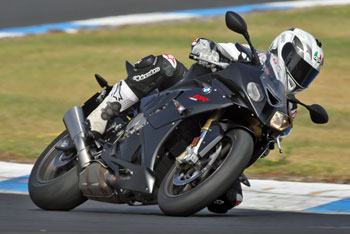
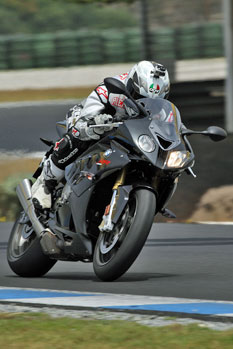
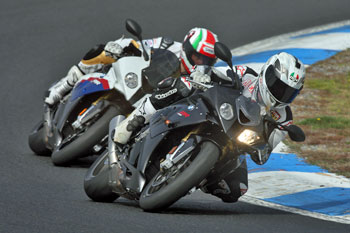
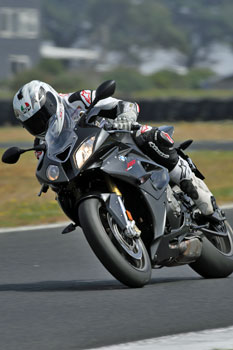
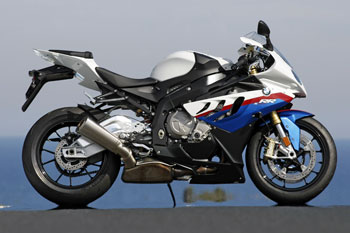
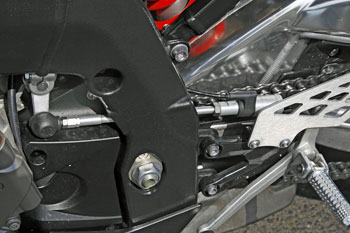
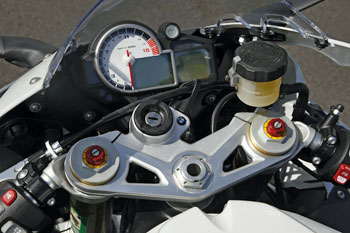
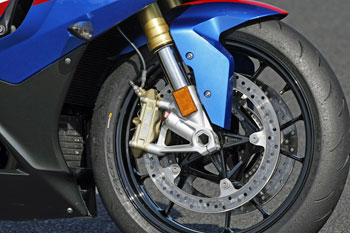
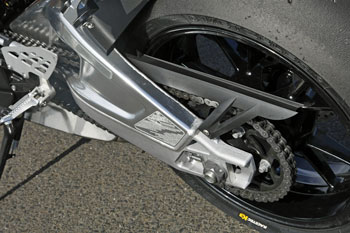
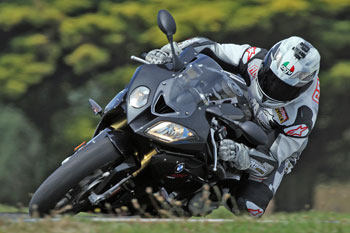





Newsletter